Exhibit 99.5

| US Market Update Scott Barnett |

| US Market Update Scott Barnett |
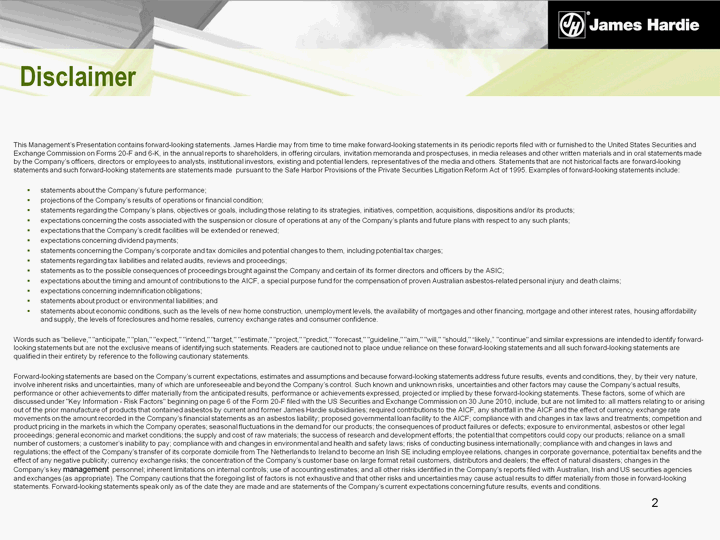
| Disclaimer This Management's Presentation contains forward-looking statements. James Hardie may from time to time make forward-looking statements in its periodic reports filed with or furnished to the United States Securities and Exchange Commission on Forms 20-F and 6-K, in the annual reports to shareholders, in offering circulars, invitation memoranda and prospectuses, in media releases and other written materials and in oral statements made by the Company's officers, directors or employees to analysts, institutional investors, existing and potential lenders, representatives of the media and others. Statements that are not historical facts are forward-looking statements and such forward-looking statements are statements made pursuant to the Safe Harbor Provisions of the Private Securities Litigation Reform Act of 1995. Examples of forward-looking statements include: statements about the Company's future performance; projections of the Company's results of operations or financial condition; statements regarding the Company's plans, objectives or goals, including those relating to its strategies, initiatives, competition, acquisitions, dispositions and/or its products; expectations concerning the costs associated with the suspension or closure of operations at any of the Company's plants and future plans with respect to any such plants; expectations that the Company's credit facilities will be extended or renewed; expectations concerning dividend payments; statements concerning the Company's corporate and tax domiciles and potential changes to them, including potential tax charges; statements regarding tax liabilities and related audits, reviews and proceedings; statements as to the possible consequences of proceedings brought against the Company and certain of its former directors and officers by the ASIC; expectations about the timing and amount of contributions to the AICF, a special purpose fund for the compensation of proven Australian asbestos-related personal injury and death claims; expectations concerning indemnification obligations; statements about product or environmental liabilities; and statements about economic conditions, such as the levels of new home construction, unemployment levels, the availability of mortgages and other financing, mortgage and other interest rates, housing affordability and supply, the levels of foreclosures and home resales, currency exchange rates and consumer confidence. Words such as "believe," "anticipate," "plan," "expect," "intend," "target," "estimate," "project," "predict," "forecast," "guideline," "aim," "will," "should," "likely," "continue" and similar expressions are intended to identify forward- looking statements but are not the exclusive means of identifying such statements. Readers are cautioned not to place undue reliance on these forward-looking statements and all such forward-looking statements are qualified in their entirety by reference to the following cautionary statements. Forward-looking statements are based on the Company's current expectations, estimates and assumptions and because forward-looking statements address future results, events and conditions, they, by their very nature, involve inherent risks and uncertainties, many of which are unforeseeable and beyond the Company's control. Such known and unknown risks, uncertainties and other factors may cause the Company's actual results, performance or other achievements to differ materially from the anticipated results, performance or achievements expressed, projected or implied by these forward-looking statements. These factors, some of which are discussed under "Key Information - Risk Factors" beginning on page 6 of the Form 20-F filed with the US Securities and Exchange Commission on 30 June 2010, include, but are not limited to: all matters relating to or arising out of the prior manufacture of products that contained asbestos by current and former James Hardie subsidiaries; required contributions to the AICF, any shortfall in the AICF and the effect of currency exchange rate movements on the amount recorded in the Company's financial statements as an asbestos liability; proposed governmental loan facility to the AICF; compliance with and changes in tax laws and treatments; competition and product pricing in the markets in which the Company operates; seasonal fluctuations in the demand for our products; the consequences of product failures or defects; exposure to environmental, asbestos or other legal proceedings; general economic and market conditions; the supply and cost of raw materials; the success of research and development efforts; the potential that competitors could copy our products; reliance on a small number of customers; a customer's inability to pay; compliance with and changes in environmental and health and safety laws; risks of conducting business internationally; compliance with and changes in laws and regulations; the effect of the Company's transfer of its corporate domicile from The Netherlands to Ireland to become an Irish SE including employee relations, changes in corporate governance, potential tax benefits and the effect of any negative publicity; currency exchange risks; the concentration of the Company's customer base on large format retail customers, distributors and dealers; the effect of natural disasters; changes in the Company's key management personnel; inherent limitations on internal controls; use of accounting estimates; and all other risks identified in the Company's reports filed with Australian, Irish and US securities agencies and exchanges (as appropriate). The Company cautions that the foregoing list of factors is not exhaustive and that other risks and uncertainties may cause actual results to differ materially from those in forward-looking statements. Forward-looking statements speak only as of the date they are made and are statements of the Company's current expectations concerning future results, events and conditions. 2 |

| Agenda Market Summary NAHB Starts Forecast Market Share Discussion Market Share Conclusions 3 |
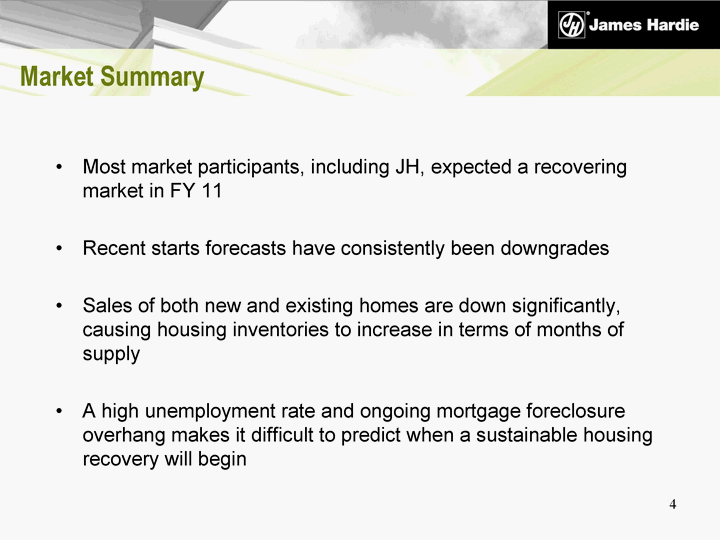
| Market Summary Most market participants, including JH, expected a recovering market in FY 11 Recent starts forecasts have consistently been downgrades Sales of both new and existing homes are down significantly, causing housing inventories to increase in terms of months of supply A high unemployment rate and ongoing mortgage foreclosure overhang makes it difficult to predict when a sustainable housing recovery will begin 4 |

| NAHB Starts Forecast Chronology 5 |

| Composition of North American Housing Starts FY 11 (forecast*) FY 10 (Actual) US - All 596,000 568,000 US - Multi Family High (51,000) (40,000) Canada 150,000 122,000 Addressable total 695,000 650,000 * Source: Dodge, Zelman and Associates, Canada Mortgage and Housing Corporation 6 |
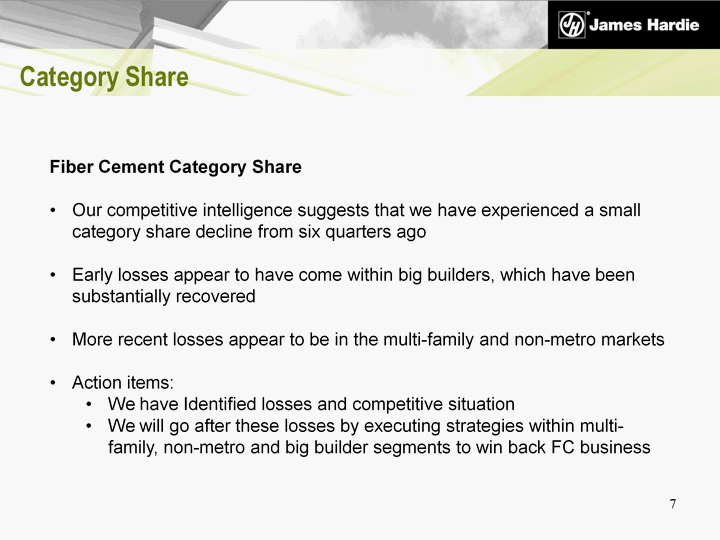
| Category Share Fiber Cement Category Share Our competitive intelligence suggests that we have experienced a small category share decline from six quarters ago Early losses appear to have come within big builders, which have been substantially recovered More recent losses appear to be in the multi-family and non-metro markets Action items: We have Identified losses and competitive situation We will go after these losses by executing strategies within multi- family, non-metro and big builder segments to win back FC business 7 |
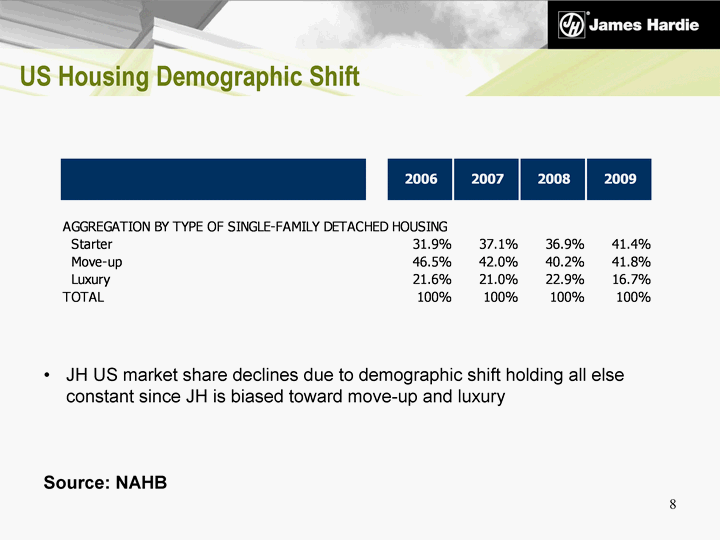
| US Housing Demographic Shift JH US market share declines due to demographic shift holding all else constant since JH is biased toward move-up and luxury Source: NAHB 8 |
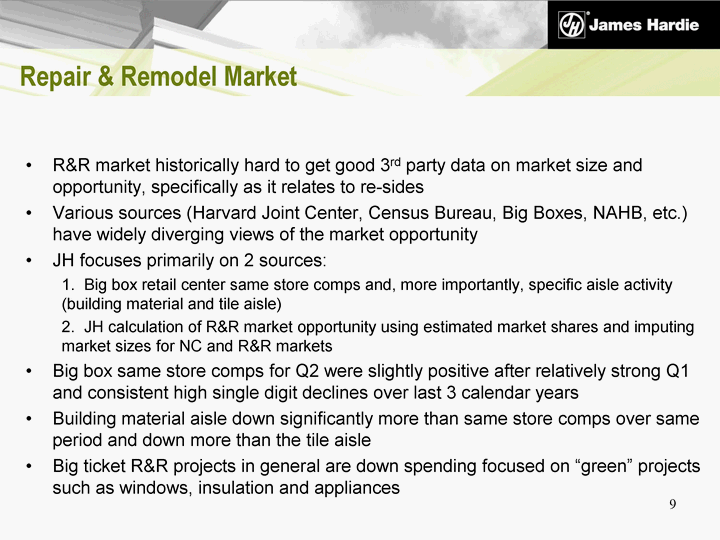
| Repair & Remodel Market R&R market historically hard to get good 3rd party data on market size and opportunity, specifically as it relates to re-sides Various sources (Harvard Joint Center, Census Bureau, Big Boxes, NAHB, etc.) have widely diverging views of the market opportunity JH focuses primarily on 2 sources: 1. Big box retail center same store comps and, more importantly, specific aisle activity (building material and tile aisle) 2. JH calculation of R&R market opportunity using estimated market shares and imputing market sizes for NC and R&R markets Big box same store comps for Q2 were slightly positive after relatively strong Q1 and consistent high single digit declines over last 3 calendar years Building material aisle down significantly more than same store comps over same period and down more than the tile aisle Big ticket R&R projects in general are down spending focused on "green" projects such as windows, insulation and appliances 9 |
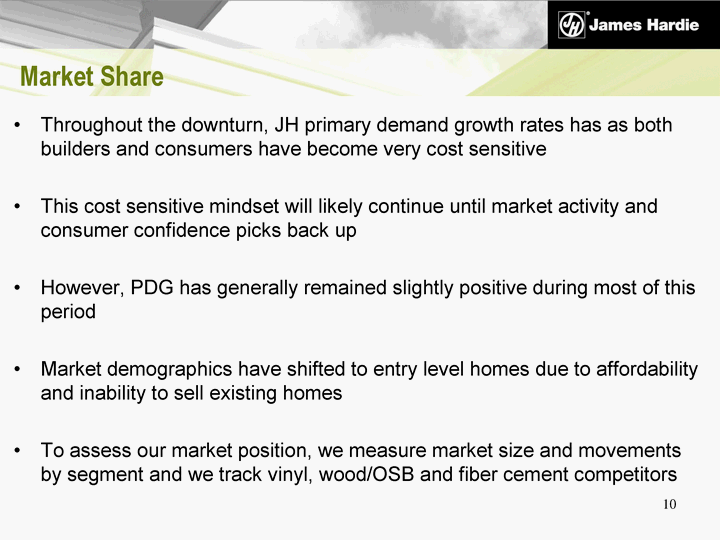
| Market Share Throughout the downturn, JH primary demand growth rates has as both builders and consumers have become very cost sensitive This cost sensitive mindset will likely continue until market activity and consumer confidence picks back up However, PDG has generally remained slightly positive during most of this period Market demographics have shifted to entry level homes due to affordability and inability to sell existing homes To assess our market position, we measure market size and movements by segment and we track vinyl, wood/OSB and fiber cement competitors 10 |
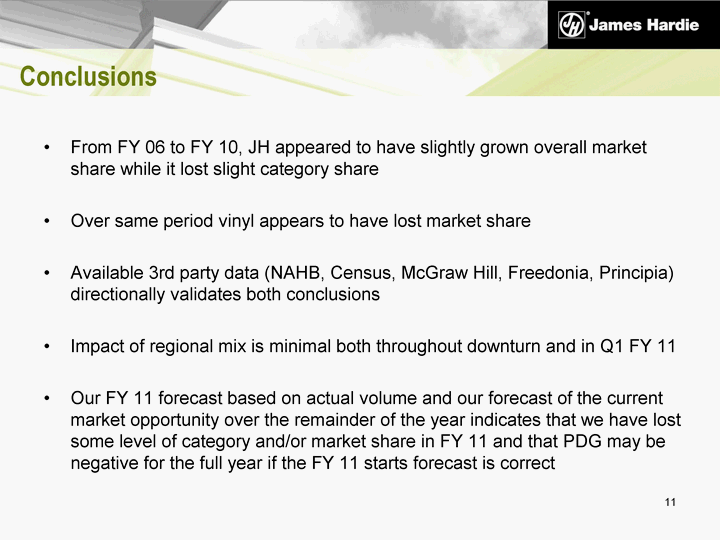
| Conclusions From FY 06 to FY 10, JH appeared to have slightly grown overall market share while it lost slight category share Over same period vinyl appears to have lost market share Available 3rd party data (NAHB, Census, McGraw Hill, Freedonia, Principia) directionally validates both conclusions Impact of regional mix is minimal both throughout downturn and in Q1 FY 11 Our FY 11 forecast based on actual volume and our forecast of the current market opportunity over the remainder of the year indicates that we have lost some level of category and/or market share in FY 11 and that PDG may be negative for the full year if the FY 11 starts forecast is correct 11 |

| Conclusions (continued) Drivers of the lost market share are: Increased price gap of JH to close alternative materials (OSB, FC, wood) Our management of non-metro markets was not at the right level given the increasing price gaps to JH With no housing recovery in sight, price has become more sensitive Demographic bias toward the lower end of the market in new construction Issue: Throughout the downturn, if Vinyl has lost market share and FC has gained some of that market share, then which other cladding material is winning? 3rd party data sources are pretty consistent in showing small to medium wood share gains. However, this is very difficult to measure based on available data 12 |

| Questions |